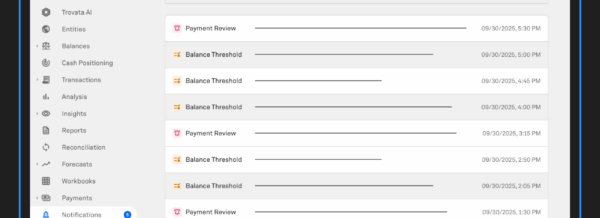Accurate cash flow analysis is integral to maintaining the health and viability of an enterprise. Accurate cash flow or cash forecasting analysis hinges on two crucial factors: access to accurate data and visibility into your organization’s extensive banking accounts. These two factors provide multiple challenges to every finance manager.
An analysis or forecast is only as accurate as the data that goes into it, and the conventional methods of capturing bank data are prone to human error. First, the manual process of recording bank transactions across multiple banks is exhausting and repetitive, which is why human error is responsible for 78% of data inaccuracies and losses. Secondly, using Excel sheets to generate finance data at the end of a business day also relies on manual effort, and the consolidation process when compiling monthly reports is time-consuming. The fact that 17% of individuals erroneously delete customized Excel formulas also highlights the impact of human error.
Kick-starting any cash flow analysis with faulty data is a premise for failure, and accounting errors are expensive. The $80 million fine Monsanto, an agribusiness, had to pay in 2016 for its accounting errors highlights the financial repercussions that also affected its public image.

The Future of Cash Flow Analysis
To understand the future of cash flow analysis, insight into past and present cash flow management tech options is required. The introduction of treasury management systems (TMS) and electronic data transfer options were expected to fix the challenges associated with collating bank data. Although early cash management systems eliminated the task of manually capturing bank data, onboarding and integrating them into existing systems weren’t seamless activities.
Although most TMS service providers promise seamless integration and usage of their solutions, the reality is different. Utilizing the average TMS can be a clunky and frustrating process where automation is absent; in a recent fireside discussion, Square’s Treasurer Tim Murphy said he used and implemented many treasury systems and “hated” each one I’ve ever worked with.
This sentiment is shared by many finance managers across the world, as can be seen in any forum where cash flow analysis is discussed.
The MT940 file format is outdated in terms of automating data collation. Auto-matching payment rates can be as low as 20%, which leaves you manually processing approximately 80% of your organization’s bank statements. Although the BAI2 format can deliver approximately 65% automation, the manual task needed to process the shortfall is also time-consuming.
Although BAI2 has standardized information exchanges across financial institutions, challenges with automating data collection and discrepancies in file information require a more effective solution to deliver intuitive cash flow analysis.
Enter bank APIs.

Digitizing Cash Flow Analysis with Open Banking APIs
Utilizing cutting-edge digital transformation technologies with the ability to automate and execute cash flow analysis in real-time is the future every finance manager expects – APIs are the key to that future.
Application Programming Interfaces (APIs) use a modular approach that simplifies and supports data sharing in real-time across multiple financial institutions. Thus, delivering real-time multi-banking data reporting which is crucial to accurate cash flow analysis.
Unlike the traditional manual reconciliation process and the use of MT940 file exchange format, APIs automatically extract data required for cash flow analysis. The automated extraction process reduces finance managers’ workload and enables you to focus on analytical and strategic planning activities. APIs’ ability to access financial data across diverse channels provides a foundation for developing custom applications and services to ease cash management and analytical tasks.
How APIs Power the Future of Cash Flow Analysis
Take, for example, a global fintech company with an account-intensive business model where teams need to produce accurate cash forecasts in real-time to deliver optimized customer services. The company will require a solution that delivers insight into real-time transaction reports against real-time balance reports to know its cash positions consistently. The reporting is expected to include its 50 bank accounts in different financial institutions worldwide.
A treasury management system that integrates an API gateway will enable the automated exchange and collation of information in real-time across the enterprise’s multiple banks. The collected financial data from its 50 banks are then visualized on a dashboard providing a single source of truth for the finance manager to work with. A finance manager can track cash flow across all banking channels in real-time to gain insight to make accurate cash forecasts.
Although API is the pipeline that connects multiple banks and automates data collection/reporting tasks, another artificial intelligence and machine learning (AI / ML) digital transformation technology makes complex analysis possible; platforms that integrate AI and ML provide the tools for automatically consolidating cash data, aggregating data, exploring and discovering patterns where they exist. The insight from AI-enabled analysis provides the actionable insight a finance manager leverages to make informed decisions.
Recommended: Why Savvy Treasurers Are Taking an API-First Approach to Cash Management
Automated Cash Flow Analytical Tools
A turnkey platform leverages API, AI, and ML’s power to deliver automated cash flow analysis to ease the finance management task. A turnkey solution leverages APIs to capture data from multiple financial systems, including enterprise resource planning platforms, and utilizes AI to gain deep insight into an organization’s financial position.
A seamless automated cash management tool simplifies the process of using API features for cash forecasting, management, and analysis. A best-in-class cash management platform must consolidate turnkey features with seamless integration to ensure ease of use.
Read Krispy Kreme’s success story to learn how they implemented Trovata to scale treasury with bank APIs.




